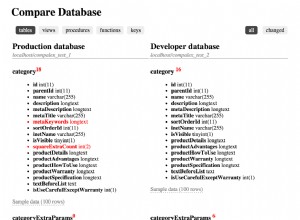Questa configurazione dovrebbe farti andare avanti. Ho cercato di mantenere la denominazione il più semplice possibile.
users
id
username
challenge_user
user_id
challenge_id
challenges
id
name
topic_id
category_id
topics
id
name
categories
id
name
Definire i tuoi modelli eloquenti
class User extends Eloquent {
public function challenges() {
return $this->belongsToMany('Challenge');
}
}
class Challenge extends Eloquent {
public function users() {
return $this->belongsToMany('User');
}
public function topic() {
return $this->belongsTo('Topic');
}
public function category() {
return $this->belongsTo('Category');
}
}
class Topic extends Eloquent {
public function challenges() {
return $this->hasMany('Challenge');
}
}
class Category extends Eloquent {
public function challenges() {
return $this->hasMany('Challenge');
}
}
Utilizzando i tuoi modelli eloquenti... solo alcuni esempi di cosa puoi fare.
// Collection of all Challenges by Topic name
Topic::with('challenges')->whereName($topic_name)->first()->challenges;
// Collection of all Challenges by Category name
Category::with('challenges')->whereName($category_name)->first()->challenges;
// Collection of all Users by Challenge id
Challenge::with('users')->find($challenge_id)->users;
// Collection of Users with atleast 2 Challenges
User::has('challenges', '>', 1)->get();
// Attach Challenge to User
$user = User::find($id);
$user->challenges()->attach($challenge_id);
// Assign a Topic to a Challenge
$challenge = Challenge::find($challenge_id);
$topic = Topic::find($topic_id);
$challenge->topic()->associate($topic);
$challenge->save();
Riferimenti e letture consigliate:
Relazioni eloquenti di Laravel
belongsTo belongsToMany hasMany
Interrogazione delle relazioni
Model::has()
Carico impaziente
Model::with()
Proprietà dinamiche per l'accesso alle relazioni
Risolvi $model->relationship
Inserimento di modelli correlati
attach() associate()
Lavorare con le tabelle pivot Se hai bisogno di recuperare dati extra dalla tabella pivot.




